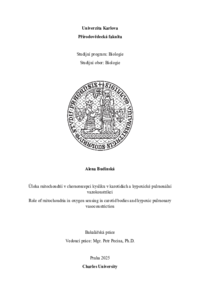Úloha mitochondrií v chemorecepci kyslíku v karotidách a hypoxické pulmonální vazokonstrikci
Role of mitochondria in oxygen sensing in carotid bodies and hypoxic pulmonary vasoconstriction
bachelor thesis (DEFENDED)

View/
Permanent link
http://hdl.handle.net/20.500.11956/199480Identifiers
Study Information System: 279500
Collections
- Kvalifikační práce [21258]
Author
Advisor
Referee
Plecitá, Lydie
Faculty / Institute
Faculty of Science
Discipline
Biology
Department
Department of Cell Biology
Date of defense
4. 6. 2025
Publisher
Univerzita Karlova, Přírodovědecká fakultaLanguage
Czech
Grade
Excellent
Keywords (Czech)
akutní hypoxie, mitochondrie, karotická tělíska, hypoxická plicní vasokonstrikce, elektron transportní řetězecKeywords (English)
acute hypoxia, mitochondria, carotid body, hypoxic pulmonary vasoconstriction, electron transport chainHypoxie může být pro většinu organismů velmi nebezpečná. Vnímání akutního poklesu kyslíku je proto nezbytné. Cílem této práce je shrnout poznatky o tomto mechanismu v tkáních senzitivních na parciální tlak kyslíku, konkrétně v karotických tělískách a hladkých svalových buňkách plicních tepen. Důraz je kladen především na roli mitochondrií. Ty byly navrhovány jako možný senzor již ve druhé polovině minulého století při pokusech s inhibitory elektron transportního řetězce. Tuto hypotézu potvrzují i modernější studie využívající deleci různých podjednotek mitochondriálních respiračních komplexů. Nejnovější výsledky pak ukazují, že kyslík-senzitivní tkáně exprimují nekanonické izoformy podjednotek cytochrom c oxidázy, což by tento komplex mohlo předurčovat k roli kyslíkového senzoru. I přes všechny tyto získané poznatky je v této oblasti mnoho nejasností a protichůdných hypotéz, které budou také diskutovány v následujícím textu.
Hypoxia can be very dangerous for most organisms. Perception of acute oxygen depletion is therefore essential. The aim of this bachelor thesis is to summarize the knowledge of this mechanism in oxygen-sensitive tissues, specifically in carotid bodies and pulmonary artery smooth muscle cells. In particular, the role of mitochondria is emphasized. They were proposed as a possible sensor as early as the second half of the last century in experiments with electron transport chain inhibitors. This hypothesis is supported by more recent studies using deletion of various subunits of mitochondrial respiratory complexes. Recent results show that oxygen-sensitive tissues express non-canonical isoforms of cytochrome c oxidase subunits, which could predispose this complex for the role of an oxygen sensor. Despite all these findings, there are many uncertainties and conflicting hypotheses in this area, which will also be discussed in the following text.
